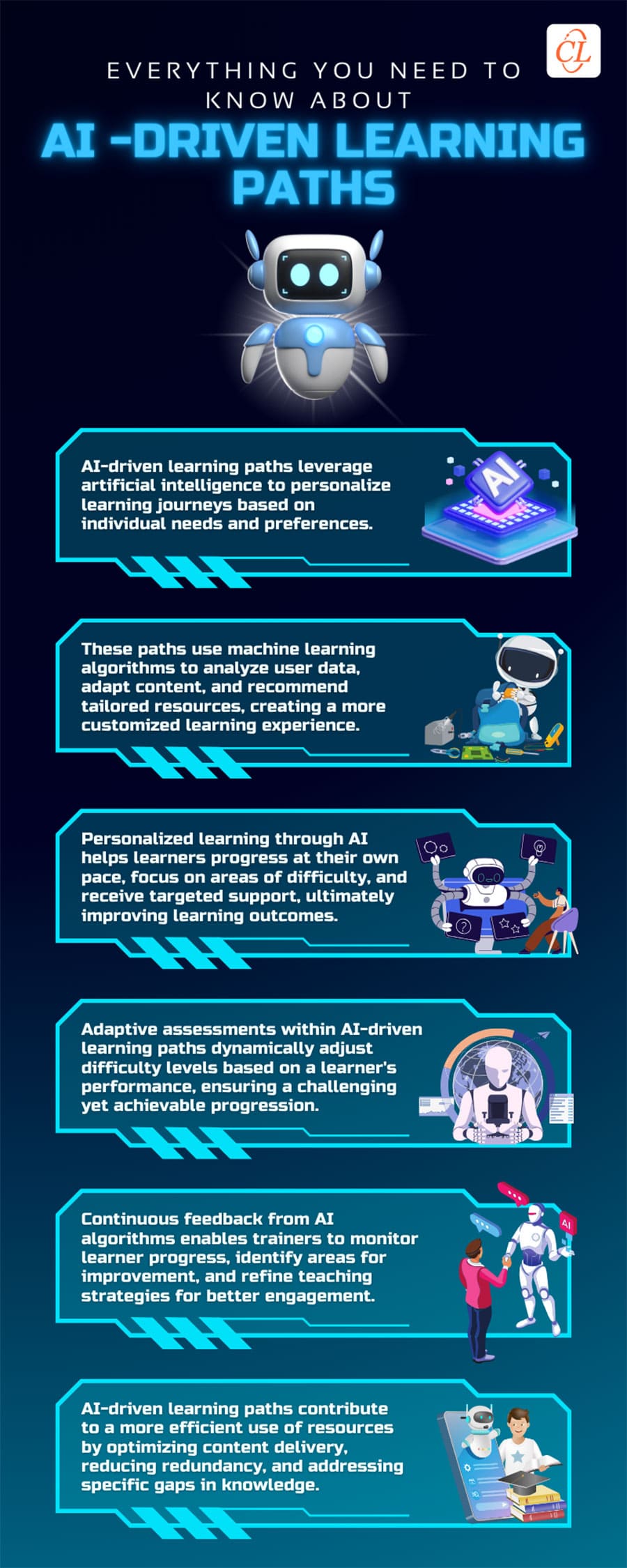Leveraging AI-Driven Learning Paths for Enhanced Learning [Infographic]
AI-driven learning paths emerge as the force to enable employees to experience tailor-made training, calibrated to their strengths and areas for growth.

Imagine you're part of a large organization with diverse teams spread across the globe. Traditional training methods struggle to address the unique needs and learning styles of each employee. Here's where AI-driven learning paths step in to transform corporate training. When corporate training is powered by AI, it takes note of your role, past training performance, and even your preferred learning formats, whether it's videos, interactive modules, or any other format. The AI analyzes this data to create a personalized learning path just for you.
Let's say you excel in project management but need a bit more support in data analytics. The AI recognizes this and tailors your learning journey. It may suggest advanced project management courses, sprinkle in microlearning data analytics modules, and even recommend other courses suitable for you.
As you progress, the AI doesn't stop there. It continually assesses your performance, noting where you shine and identifying areas that may need reinforcement. If a new training module aligns with your career goals or interests, the AI seamlessly incorporates it into your curriculum.
What are AI-driven Learning Paths?
The personalized and adaptive learning journeys that are dynamically curated by artificial intelligence based on each learner's needs, preferences, and performance are referred to as AI-driven learning paths. These learning pathways make use of machine learning algorithms to evaluate data and determine what kinds of activities and content a learner should engage with throughout their learning experience.
Here's an infographic illustrating the key features of AI-driven learning paths. Take a peek to learn more.
→ Download Now: Redefining Generative AI for Dynamic L&D Teams [eBook]
AI-driven Learning Paths — What do they Offer?
1. Personalization
AI analyzes learner data like their preferences and learning styles. It then tailors the content and progression of the learning path to suit the individual learner's needs.
2. Adaptability
As learners progress through the eLearning course, AI continuously assesses their performance and adjusts the learning path accordingly. If a learner is excelling in certain areas, the system may accelerate their progression. Conversely, if challenges arise, then AI may provide additional support.
3. Recommendations
AI can offer personalized recommendations for additional courses, based on the learner's profile. This ensures that the learner receives a well-rounded training and has the opportunity to delve deeper into areas of interest.
4. Real-time Feedback
AI-driven learning paths provide real-time feedback to learners, highlighting areas of strength and areas that may require more attention. This immediate feedback loop enhances the learning experience and facilitates continuous improvement.
5. Data Analysis
AI analyzes vast amounts of data to identify learning patterns and trends. This data-driven approach enables the system to make accurate predictions about a learner's future performance and tailor the learning path accordingly.
6. Efficiency
By automating the learning path creation and adaptation process, AI streamlines the eLearning experience. Learners benefit from a more efficient and targeted approach to acquiring knowledge and skills.
To Conclude!
AI-driven learning paths revolutionize eLearning by moving away from one-size-fits-all approaches. They embrace the individuality of each learner, providing a personalized and adaptive learning journey that maximizes engagement, knowledge retention as well as learning outcomes. This not only boosts individual professional development but also contributes to the overall success of the organization’s training initiatives in a rapidly evolving corporate world. Explore the impact of AI on employee training and discover cutting-edge tools and strategies for upskilling and unlocking unparalleled growth in our latest eBook.







